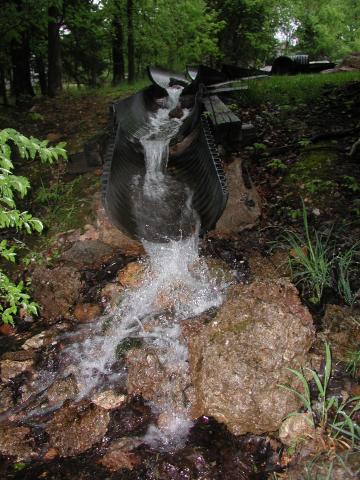The city of Camdenton’s Mulberry Well is located about 600 feet southeast of the 221 Sunset Drive manufacturing facility, and 1,000 feet south of former City Lagoon #3. Until 1999, the Mulberry Well was the highest producing well in Camdenton's public drinking water system, supplying approximately 2,107 people.
Well History
In March 1993, the Missouri Department of Health and Senior Services detected trichloroethylene (TCE), also referred to as trichloroethene, in the Mulberry Well at a level below the maximum contaminant level (MCL) for drinking water, which is five parts per billion (ppb). MCLs are the maximum amount of specific contaminants allowed to be present in drinking water supplied by a public water system, as established under the federal Safe Drinking Water Act. The department analyzed water samples collected by the city of Camdenton in April 1994. TCE was not detected.
As required by the three-year monitoring cycle for volatile organic compounds, the Mulberry Well was sampled again in January 1997. TCE was detected at 3.8 ppb, which was below the MCL. The well was sampled quarterly in 1997, and all sample results were below the MCL.
The first time TCE was detected above the MCL was in February 1998, at 6.3 ppb. MCLs use a yearly running average. In February 1999, the Mulberry Well showed TCE at 26.2 ppb. Due to the TCE levels, the city officially took the Mulberry Well offline in February 1999. A monitoring well located near former City Lagoon #3 contained TCE at 1,400 ppb. The Mulberry Well was disconnected from the city's water supply system and is no longer used for drinking water.

Contamination Control
The city of Camdenton periodically pumps Mulberry Well, in order to pull the TCE contaminated groundwater towards Mulberry Well and away from the other city and private wells. Under a department-issued Missouri State Operating Permit (MO-00124389), the city is allowed to pump the well, treat the water and discharge the treated water to a nearby stream. The water from the Mulberry Well pump moves through a PVC pipe laying in a plastic culvert. The PVC pipe is punctured with tiny holes to add air to the water, much like the aerator on a household faucet. The aerated water then moves downhill to the stream through a series of plastic troughs lined with rocks, which continues to aerate the water. By aerating the water, any TCE in the groundwater evaporates into the air. The amount of TCE in the air is very small and diluted, and is no longer a health concern.
The state operating permit requires regular sampling to show that any TCE remaining in the groundwater is below the permitted level before it enters the nearby stream. The permit allows a discharge limit of up to 80 ppb. According to the most recent sample results, the water entering the stream is below the discharge limit. Listed below are the cumulative reports for the three most recent calendar years. To review or obtain copies of sample results from previous years, please submit an Open Record/ Sunshine Law Request. If you would like assistance in understanding how to read and interpret the data, visit Understanding Data.
- Mulberry Well Analytical Results, Calendar Year 2025
- Mulberry Well Analytical Results, Calendar Year 2024
- Mulberry Well Analytical Results, Calendar Year 2023
City of Camdenton Active Public Drinking Water Wells
Every year in April, the city of Camdenton collects samples from the three active public drinking water wells serving the Camdenton area (Blair Heights, Hickory and North Rodeo). All public drinking water systems in Missouri have trained system operators who collect samples and send them to the department's laboratory in Jefferson City for analysis. The department analyzes these samples for volatile organic compounds.
All three currently active public wells serving the city of Camdenton meet safe drinking water standards. Multiple years of sampling demonstrate TCE is not present in Camdenton's active public drinking water wells. For results of all sampling, dating back to 1997, visit the department's Drinking Water Viewer website.

